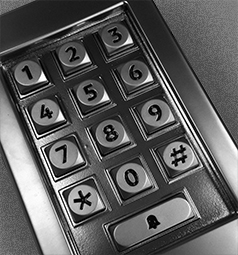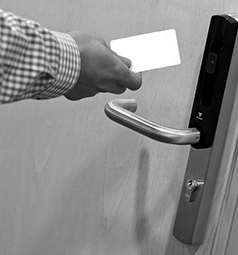ACCESS CONTROL
The term ‘Access Control’ generally refers to a system that can control, monitor and restrict the movement of people, assets or vehicles, in, out and around a building or site. The benefits of using an access control system include the prevention of loss or damage to capital assets and the reduced risk of personal injury to staff and visitors. Access control applications range from controlling a single entrance door to managing a large complex site. Physical access control systems comprise three main components:
1) The Physical Barrier
The physical barrier prevents the entry of unauthorised personnel and has a means of granting access electrically. These may be; a door fitted with an electric locking device, a turnstile, a parking gate or a lift. For doors, a magnetic door sensor may be added to monitor the door position, so that an alarm can be raises if the door is left open or opened illegally. Because there is no means of ensuring that only one person passes through a door when it is unlocked, strict rules must be in place to deter authorised users from allowing unauthorised people access through the door.
2) The Access Controller and Reader
The physical barrier is electronically controlled by an access controller combined with some form of reader to identify people by their 'credentials'. This may be a keypad, a card reader or a biometric reader. Together, the access controller and the reader provide the ability to identify an individual and authorise or deny entry to them.
Access controllers may either be ‘stand-alone’ or networked to a master PC-based (also known as ‘on-line’) access control system that manages the user database for all access points. The PC-based system software can update each controller with the details of each individual’s access rights.
PC-based access control systems can offer many additional facilities such as user location, attendance and usage monitoring, visitor management and automatically unlocking doors during emergencies and assigned periods.
3) Credentials
The identity of an individual is determined by a ‘credential’, which may be a PIN code, an access card, key fob, or a unique human characteristic such as a fingerprint. In some cases, combinations of two or more of these credentials may be used to identify the person.


© Scott Total Security Ltd 2022